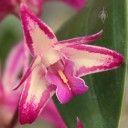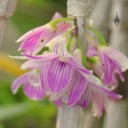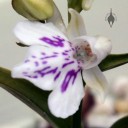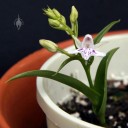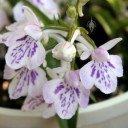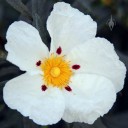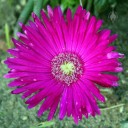Outdoor Orchids in San Francisco
Posted April 16th, 2012 by Marc CohenCategories: Cool Growers, Growing, Growing Orchids in San Francisco, Intermediate Growers
Welcome to a new blog category for “Growing Orchids in San Francisco” with info of interest for the Bay Area. Some old posts fit the new category, too, so I’ll go back and re-label those with local relevance.
This post is the first half of a list of orchids I’ve grown outdoors over the years, with a few notes added. They’re all cool or intermediate growers, befitting San Francisco’s mild, foggy climate. Most have survived an occasional hailstorm, and we’ve managed to protect them from our rare winter freezes. For fellow gardeners in Sunset climate zone 17 where microclimates rule, you may find varieties that will work outdoors for you. The second half of this list will follow in a future post.
- Ada aurantica grows and blooms reliably every spring.
- Arpophyllum giganteum flowers dependably every fall. A few seed capsules appear each year.
- Bletilla striata grows and blooms reliably every spring.
- Chondrorhyncha lendyana flowered well, but died after repotting. I believe it prefers to be mounted.
- Cochlioda vulcanica grows and blooms faithfully every fall. Flowers often last through the winter into spring.
- Coelia bella was a new purchase last year, and flowered nicely for the first time last winter.
- Coelogyne mooreana grows and flowers reliably every summer.
- Cymbidiums guarantee blooms every winter. One of my hybrids has never failed in 15 years, and another blooms a second time in spring.
- Cyrtochilum macranthum flowers dependably with dozens of large blossoms at the end of each summer.
- Dendrobium kingianum and Dendrobium x delicatum grow and bloom reliably every spring, Den. kingianum needs a dry winter, but the Den. x delicatum hybrid can tolerate winter rains and still bloom.
- Dichaea glauca has grown for years but never flowered. I’ve tried it indoors too, without success. It continues to put out new growth each year, so there’s still hope I’ll figure it out.
- Dockrillia striolata didn’t bloom for the first 6 years I had it, but now blooms each spring.
- Domingoa (Nageliella) purpurea has flowered over the past 2 summers.
- Dracula sodiroi flowers sporadically. It might be more reliable if I used purified water instead of tap water, but I’m not set up for that outdoors.
- Encyclia vespa grew and bloomed well for many years. It required full sun.
- Epidendrums flower continuously for years. Keikis of cool-growing varieties turn into large plants within 3 years. The most vigorous type, which may be Epidendrum x obrienianum, is pollinated by local Anna’s Hummingbirds. Seed capsules often form, and seed is viable. Seedlings pop up in nearby bonsai pots, and can grow to flower in 3 years.
- Epipactis gigantea, a San Francisco native, grows and flowers vigorously each summer. Seed capsules occasionally form. It lives in a tray of water all year, even during winter dormancy.
- Helcia sanguinolenta blooms every other year in winter.
- Holcoglossum kimballianum has grown outdoors for 2 years, but not flowered yet. It lives indoors over winter.
- Laelia anceps thrives and blooms 2 or 3 times each year.
- Lemboglossum majale has only flowered once over the years. It may prefer warmer nighttime temps than we have.



